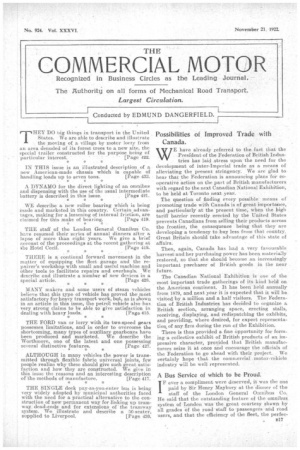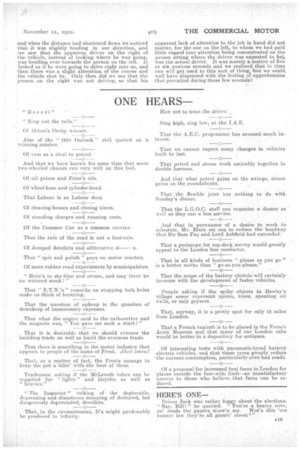Possibilities of Improved Trade with Canada.
Page 1

Page 2

Page 3

If you've noticed an error in this article please click here to report it so we can fix it.
E have already referred to the fact that the President of the Federation of British Indus tries has laid _stress upon the need for the development of inter-Im.perial trade as a means of alleviating the present stringency. We are glad to hear that the Federation is announcing plans for cooperative action on the part of British manufacturers with regard to the next Canadian National Exhibition, to be held at Toronto next. year. • . .
The question of finding every possible means of Promoting trade with Canada is of great importance, and particularly at the 'present time, when the high tariff barrier recently erected by the United States prevents Canadians from selling their products across the frontier, the consequence being that they are developing a tendency to buy less from that country. Great Britain should take advantage of this state of affairs.
Then, again, Canada. has had a very favourable harvest and her purchasing power has been materially restored, so that she should become an increasingly important purchaser of British goods in the near future. . .
The Canadian National Exhibition is one of the most important trade gatherings of its kind held on the American continent. It has been held annually from 1879, and next year it is expected that it will be visited. by a million and a half visitors. The Federation of British Industries has decided to organize a British section, arranging space, erecting stalls, receiving, displaying, and redispatehing the exhibits, and providing, where desired, for expert representatiok of any firm during the run of the Exhibition.
There is thus provided a fine opportunity for forming a collective exhibit of British products of an impressive character, provided that British manufacturers seize it at once and encourage the officials of the Federation to go ahead with their project.. We certainly hope that the commercial motor-vehicle industry will be well represented.
A Bus Service of which to be Proud.
IF ever a compliment were deserved, it was the one paid by Sir Henry Maybury at the dinner of the staff of the London General Omnibus Co. He said that the outstanding feature of the omnibus. system of London was the great courtesy shawn by all grades 'Of the road staffto -passengers and road -users, and that the efficiency of the fleet, the perfec
Lion of the service, and the freedom from accidents made the bus system a pattern to the whole world.
This is perfectly true. We have never experienced, in the course of a considerable amount of traffic driving, a single unkind, sharp, or discourteous action on the part of a bus driver, nor can we recall any careless act or incident showing want of attention to his job by the man at the wheel of a bus. That is not by any means strange, for the right spirit is engendered in the men in the course of their training by the special department of the company devoted to the instruction of the men, but what might not be expected is our ability to assert (touching wood!) that, although we travel some thousands of miles per annum by bus and have done so for more years than we care to remember, we have never once been on a bus that has been, involved in a mishap of any kind. It has been our pleasure to meet many visitors from overseas and to hear their views upon those domestic matters which strike them as possessing peculiar interest in London, and we invariably hear that what appeals to them first and foremost is the excellenoe of London's bus service, and what excites their admira tion are the courtesy, skill, and carefulness of the bus driver. We always take a delight in giving these visitors letteas of introduction, which secure for them (thanks to the amiability and spirit of helpfulness of the L.G.O.C. engineering staff) the entree to the Chiswick overhaul factory and to some of the garages, and without exception the visitors leave London profoundly impressed with the magnitude, efficiency, and value of London's bus system.
It is because the L.G.O.C. does its job so well— opening up new routes, and maintaining them through their unremunerative periods, until they do pay or are proved unnecessary—that we agree that it is not fair for competing concerns to place buses on routes already adequately served. There are still a number of fields open, the cultivation Of which would be advantageous to passenger transport, and we suggest that a careful study, by new concerns, of the requirements of the travelling public in London would reveal the opportunities that undoubtedly exist and provide the basis for quite a remunerative business in catering for those needs Petrol v. Steam in Heavy Transport.
IF we are to believe all the claims of the steamwagon manufacturers, there is nothing which can compare with this type of vehicle for the transport of heavy loads. In a great many instances we certainly believe that they are correct, but, after all,
it is only by use that claims of this nature can be sub stantiated, and if we turn for guidance to those :who employ different types of vehicles we often find the heavy petrol wagon and the heavy steam wagon woeking side by side, and dealing with loads which are substantially the same. In our opinion, the whole question as to which is the more suitable vehicle depends entirely upon the radius of operation, the number of stops made, and the speed at which the loads have to be carried, and each ease must, therefore, be judged on its merits. The 'actual running costs of the two types of vehicles are approximately the same ; in fact, if anything, the balance is in favour of the petrol vehicle, but the steam vehicle has the advantage that it can be employed in the majority of instances in conjunction with a trailer, in which case the cost per ton-mile is considerably reduced. Admittedly, some petrol vehicles can also be used satisfactorily with a trailer, but this does not apply in the majority of eases, as the petrol engine has not the degree of flexibility which is possessed by its steam confrare. Again, we must look at the matter from the point of view of the attention required by the two types. The driver of a steam wagon has to be a far better B18
man at his job than the driver of a petrol vehicle, otherwise he will not obtain the best results from his wagon ; also the latter vehicle cannot be driven straightaway in the morning, for a delay has to occur while steam is being raised. On the other hand, the steam wagon is renowned for its reliability and capacity for standing up to its job for long periods without any sign of reduced efficiency.
Taking everything into consideration, it would appear that the steam wagon finds its best sphere of employment in dealing with loads of ten tons, necessitating the use of a trailer, and for distances up to a radius of approximately 50 miles from the startingpoint, whilst the heavy petrol vehicle can advantageously be employed with loads within its capacity without the use of a trailer, for short-distance work where there is a large number of stops necessitating much waiting, and for long-distance work covering a radius of over 50 miles from the starting-point.
Vocational Training of Manual Wakers.
THERE are a certain number of concerns in the commercial motor-vehicle industry which are doing extremely good work in the training of manual workers—a course which must be to the benefit not only of that industry, but also of the transport industry, for the obvious reason that the better the knowledge possessed by the rising generation the better will be the vehicles and the easier the task of maintaining them at the highest level of efficiency.
An important body is the Association for Education in Industry and Commerce, of which Sir Archibald Denny, Bt., LL.D., P.R.S.E., is president and Mr. Neil J. Maclean, B.Sc. (Barr and Stroud, Ltd.), is chairman. This association is now collecting information from employers for the preparation of a report on " Vocational Training for Manual Workers in the Engineering Industry," and has set a number of questions to employers, which we reproduce on another page, and to which it is inviting answers from those concerns which have had experience in the training of employee. This report, when published, will, we are assured, be of immense value to the engineering industry, and for that reason we commend the questionnaire to the careful attention of those concerns in the industry which are able to answer it. , Does the Left-hand Steering Position Deceive Road Users ?
WE recently referred in these columns to the risks attendant upon the lack of uniformity in motor vehicles, caased by the introduction of cars and vans the drivers of which sit upon the left-hand side of the vehicles.
Those who have driven a vehicle with a left-hand steering position know that no special difficulty is experienced in piloting them through heavy traffic, and this is confirmed by the fact that, when driving a right-hand steering vehicle in a foreign city where the traffic keeps to the right instead of the left, no awkwardness is noticed nor does any mishap occur on account of the position of the driver. In Paris one sees as many drivers on the right side of the cars, cabs, or commercial motors as there are drivers seated on the left, but in London and other British cities and towns the left-drive vehicle is still, to an extent, a novelty. , As we have said, this lack of uniforMity does not affect the drivers of left-drive vehicles, but it does involve risks so far as other road users are concerned, and an instance of this came under our personal notice only a few days ago. The day was dull and the visibility low, and we were driving along an open road. , A landaulet was observed ahead approaching us, and when the distance had shortened down we noticed that it was slightly tending in our direction, and _sve saw that the apparent driver on the right of the vehicle, instead of looking where he was going, was bending over towards the person on the left. It looked as if he were going to drive right into us, and then there was a slight alteration of the course and the vehicle shot by. Only then did we see that the person on the right was not driving, so that his apparent lack of attention to the job in hand did not matter, for the one on the left, to whom we had paid little regard (our attention being concentrated on the person sitting where the driver was expected to be), was the actual driver. It was merely a matter of five or six anxious seconds and we realized that in time one will get used to this sort of thing, but we could.. well have dispensed with the feeling of apprehension that prevailed during those few seconds I






























